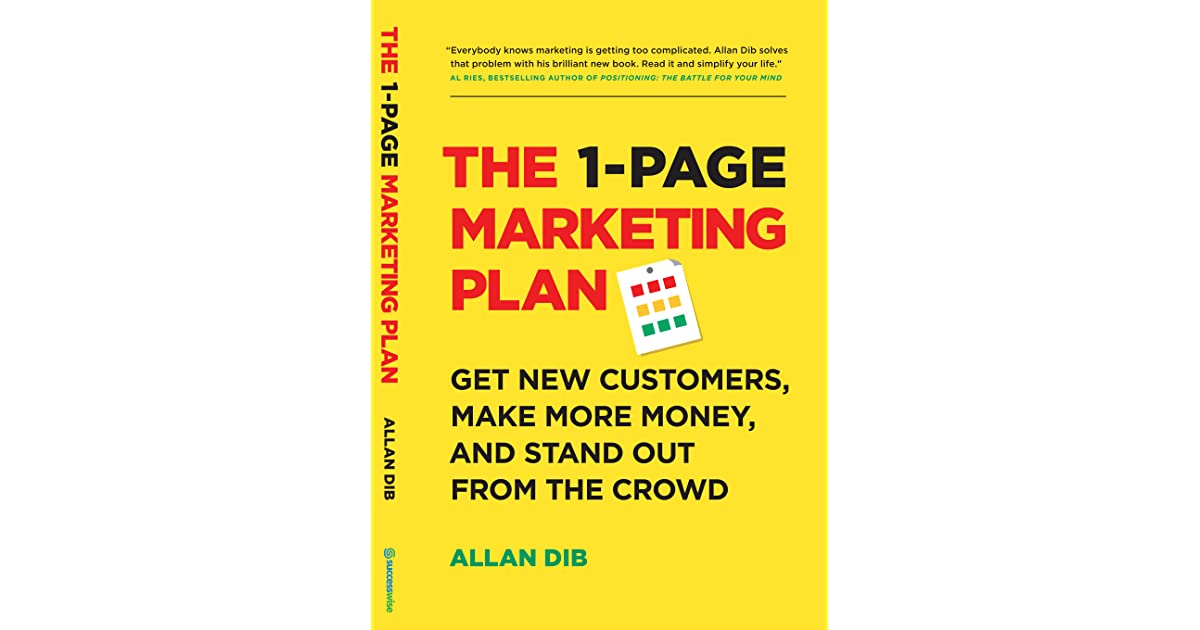What is Your Lead Nurturing System
An analysis and commentary on The 1-Page Marketing Plan
The 1-Page Marketing Plan
About the Book:
In The 1-Page Marketing Plan, Allan Dib reveals a marketing implementation strategy to map out your own sophisticated marketing plan and go from zero to marketing hero.
About the Author:
Allan Dib is a passionate entrepreneur, rebellious marketer and technology expert. As a highly sought after business coach, consultant and public speaker, he frequently shares his proven strategies and cutting edge tactics with people all over the world.
WHY IT MATTERS
Once you have a lead and they go into your database it’s important not to forget about them. 50% of salespeople give up after one contact, 65% after two, and 79.8% after three. If you imagine your database as a farm and each lead is seed then you would be the farmer. Farmers water their crops to make them grow for a harvest. It’s not immediate, each contact with your lead is a watering moment where you can nurture them to become a high-probability prospect. If you only water them once or twice your harvest will most likely be small and unsuccessful. Instead, you should have a lead nurturing model within your database that allows for repeated contact. This contact shouldn’t brow beat your leads into a sale, but build trust with them by giving value in advance of buying from you. Demonstrating your authority in your field of expertise is one way to begin building a credible and trustworthy rapport. This way when your lead is finally ready to buy, you are at the forefront as an invited guest instead of an unknown pest.
A SIMPLE THREE STEPS
There is a simple three-step process you can easily maintain to nurture your leads. First, advertise with the intention of finding people who are interested in what you do. This can be done with a free report, video, interview, or other sources. You want to position yourself as an expert and educator who can help fix their problem. Next, add them to your database. Once you find a lead it’s crucial to maintain their information and keep track of them, that way your advertising efforts are not wasted. Finally, keep in contact. You regularly want to be providing your lead with relevant and valuable information. You don’t however want to make everything you give them a sales pitch, it will become old very quickly. Instead you want to keep regular contact on good terms so you don’t become another cold salesperson that spams their inbox. It is your job to market to them until they buy or die. This may seem like advocating for being obnoxious and pestering people but it’s quite the opposite. Traditional selling techniques often focus on “always closing” which is a technique that uses pressure to push your lead into a sale. You want to stay away from this, focus on giving leads free high value information whether they are ready to buy or not. This opens them up instead of shutting them down. The sale you may have missed because a pressure tactic doesn’t work may become possible with a few weeks or a month of reliable information from your company to them. Now they trust you and your business and while they weren’t ready earlier, now they are and you’re their #1 choice.
OPTIONS FOR YOUR LEAD NURTURING SYSTEM
Here are some examples of things you can use in your lead nurturing system. Try different things out and see what works best for you and your leads.
|
Newsletter |
Blog |
Free Reports |
|
Direct Mail Sequences |
Email Sequences |
Social Media |
|
Online Video |
DVDs/Audio CDs |
Podcasts |
|
Print Ads |
SMS Auto-Responders |
Shock & Awe Packages |
These are a few core assets that you can implement within your marketing infrastructure. Each option serves a different crowd and purpose. It allows cold leads generated from ads to be plugged in and turned into raving fans. There are some questions you should ask yourself while building your marketing infrastructure. Are you constantly improving and updating it? Is what you are doing working and maximizing its value? Otherwise you may want to try different forms of media.
LUMPY MAIL AND SHOCK & AWE PACKAGES
The power of postal media should not be underestimated even as it competes with electronic mail. It is a strong media channel that you can use to your advantage. If you think about your postal sorting habits you generally end up with one pile of magazines for a rainy day and then envelopes you’ll need to open. Now imagine one of those envelopes has something in it that makes it lumpy. There’s an object in it, maybe a book, DVD, or small item of some sort. Which envelope out of the ones there do you think will get opened first and the most attention? Lumpy mail is an attention grabber and allows you to be creative with your marketing campaigns. These small items are called “grabbers” and can set the tone of the newsletter that should be in your envelope with it. Now your lead is interested in why they have received something out of the ordinary in the mail and are more interested in what you may have written. The next step up from lumpy mail is the “shock & awe package” which is a powerful direct response marketing follow-up tool. Many businesses don’t use it as a tool, instead they provide customers who request a follow-up with a link to a webpage, an email, or an uninteresting phone call. A “shock & awe package” eliminates these boring everyday responses and comes unexpectedly to a lead. Some things you can and should include in the package is a book. People are conditioned not to throw out books which makes them a good option and if it’s something you wrote, even better. This book that is being reviewed for its content right now is an example of valuable information provided that hasn’t been thrown out. You can also have DVDs or CDs that introduce yourself or the specific problems your product/service can solve. Testimonials from previous customers, clippings from media mentions or features are also strong additional information. Even coupons or gift cards can be a good idea. People hate the idea of wasting money. A sample of your product can also be very enticing since people love samples. If you have ever been to Costco and tried the food samples you know it’s very good at motivating you to actually go pick up the product they are selling. The “shock & awe package” is great at delivering a “wow” emotion to your prospect.
THE MATH
You can’t substitute good marketing for bad math. You have to be careful when using “shock & awe packages,” because your numbers need to make sense. You don’t want to be too cheap where you are not making an impact but of course you don’t want to overspend with no return. Make sure you are tracking your costs and returns when trying out new campaigns. Another bonus to this type of marketing is that most of your competitors won’t understand the actual goal of your packages. Most see it as a money dump which will make you stand out as an outlier. It’s also a great way to create a trend or niche idea that people can associate with your company as being cool or forward thinking. These packages have a domino effect on the benefits they return when used properly. An important factor of a high-growth business is that they are not timid about their offers. They take risks, use compelling and unique copy’s and make outrageous guarantees. Just as there are different people who provide different things to a company you always want to be finding different types of projects and systems to help promote and maintain your leads. Coming up with new ideas or shamelessly stealing the ones from this book are a great place to start. Hiring graphic designers, web developers, and copywriters make it real; then getting administrative help and using fulfillment services will make it recurring. Much of this can be automated and what can’t should get delegated. It’s just important to make sure you’re not neglecting it. Lack of a functional or running marketing infrastructure will harm or even kill your business.
MANAGING IT ALL
We covered a lot of things in this chapter now it’s about tracking what you decided to use. Sometimes this can be done through different calendar tasks. Daily, you should be checking social media and replying appropriately to comments and questions. Weekly, you could be writing a blog post and sending an email list with relevant links to blogs, posts, or content to your subscribers. Monthly, mailing customers a printed newsletter or postcard is a good idea. Quarterly you can send past customers who haven’t purchased anything a reactivation letter. Lastly, annually sending all customers a gift basket thanking them for their business. You can do as much or as little of these items as you want. Customize a schedule to your business and continually update for the best results. In addition to a regular schedule for marketing activities you should also consider event-triggered marketing activities. As an example, if you meet a prospect at a business event: transcribe their details from their business card then put them on your monthly newsletter/postcard list. If you get a sales inquiry send back a handwritten note and your “shock & awe package”. If you get a new email list subscriber: add them to your CRM which will automatically send them a five-part educational video series over the next 30days. You should try to automate this process as much as possible. Your time is more valuable and better spent on higher-level marketing tasks. Designing and testing new campaigns and updating your current offers should be your priority. A concern about delegating your marketing jobs is that quality will suffer. Whether someone will do what you would like up to the standard you desire will be based on who you hire and making sure to do regular check-ins. The likely answer is that no one will be able to 100% keep up with the standard you expect but if they can get up to a satisfactory 80% level you should delegate it.
THE MAJORS AND MINORS
A quote from Jim Rohn, an American Entrepreneur, captures what a successful business needs to separate and delegate versus keep at the highest level:
“Learn how to separate the majors and the minors. A lot of people don’t do well simply because they major in minor things. Don’t mistake movement for achievement. It’s easy to get faked out by being busy. The question is: busy doing what? Days are expensive. When you spend a day you have one less day to spend. So, make sure you spend each one wisely. We can no more afford to spend major time on minor things than we can to spend minor time on major things. Time is more valuable than money. You can get more money, but you cannot get more time. Time is the best-kept secret of the rich. Finally, the most common complaint is that it’s too expensive to hire or outsource help. This may have been true a few years ago, but not anymore thanks to the wonder of geoarbitrage. There is an enormous pool of talent in Southeast Asia, India and Eastern Europe that will work for you at a fraction of the price of local employees and contractors.”
Keep in mind what you should be prioritizing in order to keep your business growing. There are many outlets for you to find suitable employees to delegate or commission tasks from. Platforms like Upwork, Freelancer and 99Designs all specialize in providing various employees with specialized skills. You simply need to know what you’re looking for and start hiring. People can be hired on demand for a one-off task or added to your team to continue to produce for you. The internet has made talented specialized people so readily available and cost-efficient that you should be maximizing its potential.
HIGHLIGHTS
- Nurturing your leads once they are generated through your ad strategies is just as important as the marketing project itself.
- There are three steps you can take to nurture your leads efficiently. First, advertise with intention. Second, add them to your database and keep track of them. Third, keep in contact regularly and build a relationship.
- There are various ways you can build a nurturing system within your lead database, test different options and find what works for you.
- Never underestimate the power of lumpy mail and “shock & awe packages” they will set you apart from the crowd and when you are different you attract attention.
- Make sure you are carefully analyzing what turns a profit or causes you a loss. But, you don’t want to be too stingy about it that you miss out on sale because you didn’t want to invest a bit more in a lead.
- This isn’t a one-man-army job, you should be delegating and automating everything that you reasonably can. Your time is valuable and you don’t need to be involved in every micro step of your company.
REFERENCES:
The 1-Page Marketing Plan: Get New Customers, Make More Money, And Stand Out From The Crowd by Allan Dib





